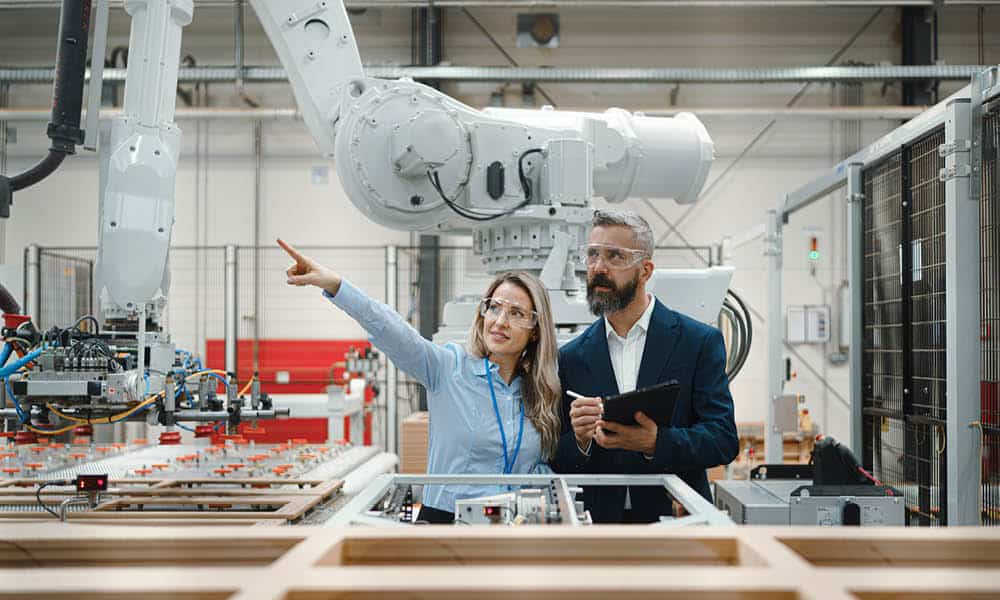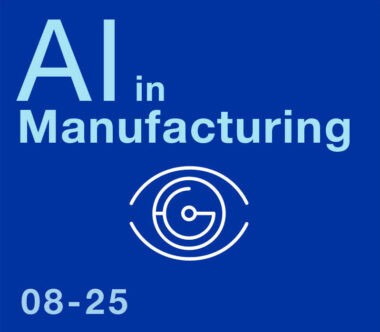Transforming Manufacturing with AI: Applications, Benefits, and How to Begin

AI is offering manufacturing benefits to the bottom line while also providing a path toward expansion into new products and services

TAKEAWAYS:
● AI and machine learning can unlock performance improvements by unraveling hidden patterns and allowing for data-driven decisions. workers with real-time information, guidance, and feedback.
● Operational benefits include improved quality, reliability, dynamic scheduling, optimized supply chains and enhanced product design.
● Successful AI deployment requires a strategic approach such as ensuring data readiness, developing skills, and planning to scale.
Artificial intelligence is transforming manufacturing, equipping organizations with advanced tools to overcome challenges and accelerate performance. AI technologies like machine learning unlock opportunities to enhance quality, reduce downtime, meet sustainability goals, and stay competitive in today’s rapidly changing marketplace.
The Role of AI and ML in Manufacturing
AI simulates human intelligence for tasks such as decision-making and pattern recognition. Machine learning automates model building using data and through making self-improvements over time. These and other related technologies rapidly process large data sets, unravel hidden patterns, and enable factories to make data-driven decisions at scale, tackling core challenges in real time.
Key manufacturing hurdles, such as equipment breakdowns, schedule disruptions and inefficiencies, are now addressed with real-time monitoring, predictive analytics, and automated optimization thanks to AI and ML.
Key Applications in Manufacturing
Quality Control
AI-driven systems use cameras and sensors to analyze products in real time and compare those images to 3D models to rapidly identify defects that manual inspections might miss. Machine learning uses historical quality data to predict and prevent emerging quality issues, ensuring high precision and reducing costly rework while minimizing waste. In addition, AI is now being used for “predictive quality” – using historical data, data analysis, and predictive algorithms to anticipate and prevent quality issues before they happen.
Predictive Maintenance
Sensors collect operational data (like vibration and temperature), while ML algorithms compare that operational data to historical operational data that preceded failures in the past to predict future failures before they happen. This proactive approach extends equipment life, lowers unplanned downtime, and helps maintenance teams shift from routine checks to targeted interventions, conserving resources and budget.
Production Scheduling
AI optimization improves production schedules by balancing resources, deadlines, and disruptions. It dynamically updates plans to keep production flowing efficiently, even during equipment failures or sudden order changes. Utilizing ML for scheduling extends this even further by analyzing the root causes of past schedule deviations and proactively suggest more informed plans to avoid future issues/delays.
Key manufacturing hurdles, such as equipment breakdowns, schedule disruptions and inefficiencies, are now addressed through AI and ML.
Sustainability
AI enhances the sustainability of operations by cutting energy use and waste through collecting data such as energy consumption and water usage and then using ML to analyze resource consumption, pinpointing opportunities for energy savings. AI can also be used to refine logistics and supply routes, reducing environmental footprint and transportation costs.
Supply Chain Optimization
AI offers an unprecedented ability to respond to changes and opportunities by analyzing real-time data, exploring scenarios within constraints, predicting disruptions, and recommending timely alternatives. By forecasting demand surges or material shortages, it equips manufacturers with the ability to pivot quickly, maintaining operational continuity and helping them meet their business goals.
Assisted Machining Programming
Programming for machining equipment like CNCs is labor-intensive, requires significant training and experience, and is critical for quality. AI can collect and examine historical data using ML to generate optimal tool paths in seconds, improving throughput and accuracy and extending tool life, especially helpful for less experienced workers.
Custom Product Design
Generative AI tools create innovative product designs by processing constraints such as cost and durability. This empowers manufacturers to offer personalized products in sectors with rising customization demands.
Benefits of Artificial Intelligence in Manufacturing
- Greater Productivity
AI automates routine processes, enabling teams to focus on strategic work and enhancing overall throughput. - Cost Savings
AI optimizes resource usage, reduces employee time, minimizes downtime, and improves equipment reliability. These capabilities reduce repair expenses, labor costs, and waste, delivering significant cost savings. - Improved Decision-Making
Manufacturers use real-time analytics to adapt to disruptions, make quick strategic decisions, and allocate resources effectively.
A proactive approach extends equipment life, lowers unplanned downtime, and helps maintenance teams shift from routine checks to targeted interventions, conserving resources and budget.
- Consistent Quality
Automated quality checks lead to fewer defects and recalls, building stronger customer trust and brand reputation. - Stronger Sustainability
Optimized energy use and material management advance sustainability goals and help satisfy increasing regulatory and consumer expectations. - Innovation and Competitive Edge
By leveraging AI, manufacturers foster innovation, whether through adaptive systems, quicker design iteration, or more agile supply chains.
Real-World Success Stories
Artificial Intelligence is already elevating performance across the manufacturing spectrum:
- Automotive: One manufacturer used automation to inspect more than 400 brackets and welding points, reducing quality inspection time by 75% and improving inspection accuracy by over 90%.
- Aerospace: Using AI-driven quality inspection, one aerospace manufacturer was able to reduce the risk of missed quality defects by 90% while reducing overall quality inspection time by 40%.
- Consumer Goods: A consumer packaged goods manufacturer is using AI-enabled logistics and supply chain planning to reduce sourcing and upstream transportation cost by 6-7% while reducing plan preparation time by 40%.
Other innovations such as factory layout design with generative AI and synthetic data for safer training continue to shape the future landscape.
Implementing Artificial Intelligence in Manufacturing
Success with AI requires a structured, strategic approach:
- Data Readiness
Reliable AI depends on quality data. This requires an investment in sensors and IoT infrastructure to ensure robust, accessible operational data and, even more importantly, a clearly defined and strictly enforced data governance process to ensure the data collected is valid, applicable and accurate. - Start with Pilot Projects
Analyze current areas of cost or inefficacy so that you can then focus on high-impact areas to validate performance and demonstrate value early on. You may find areas like predictive maintenance or quality inspection can provide quick time to value, but don’t limit yourself to evaluating those areas. - Develop Skills and Promote Collaboration
Break down silos between IT, operations, and data teams by creating cross-functional teams to foster collaboration. Provide employees with training to effectively use AI systems, ensuring they feel confident in working alongside these technologies.
By starting small, leveraging data effectively, and planning for scalability, manufacturers can unlock the full potential of AI.
- Use External Expertise
Partner with proven AI experts – service providers or consultants – to bridge knowledge gaps and accelerate solution deployment. - Proceed with Transparency
To increase employee buy-in, adopt AI systems that are easily explainable to your employees and that make decisions transparent and easy to understand. - Plan for Scalability
Choose AI solutions that can scale across multiple production lines, facilities, or supply chains, ensuring long-term value as your operations grow. - Track Measurable Impact
Demonstrate the value of AI by tracking key metrics, such as reduced downtime, higher output, or lower energy consumption, to gain executive support and secure further investment.
The Path Forward
Artificial intelligence is transforming manufacturing, addressing challenges in quality, productivity, cost, and sustainability. As AI and related technologies continue to evolve, manufacturers have an unprecedented opportunity to innovate and gain an edge in increasingly competitive markets. By starting small, leveraging data effectively, and planning for scalability, manufacturers can unlock the full potential of AI. The combination of advanced technology and human expertise offers limitless possibilities for progress. The time to embrace this transformation is now – those who act today will lead the industry tomorrow. M
About the author:

Mike Bradford is Director, Strategic Business Development, at Dassault Systémes.